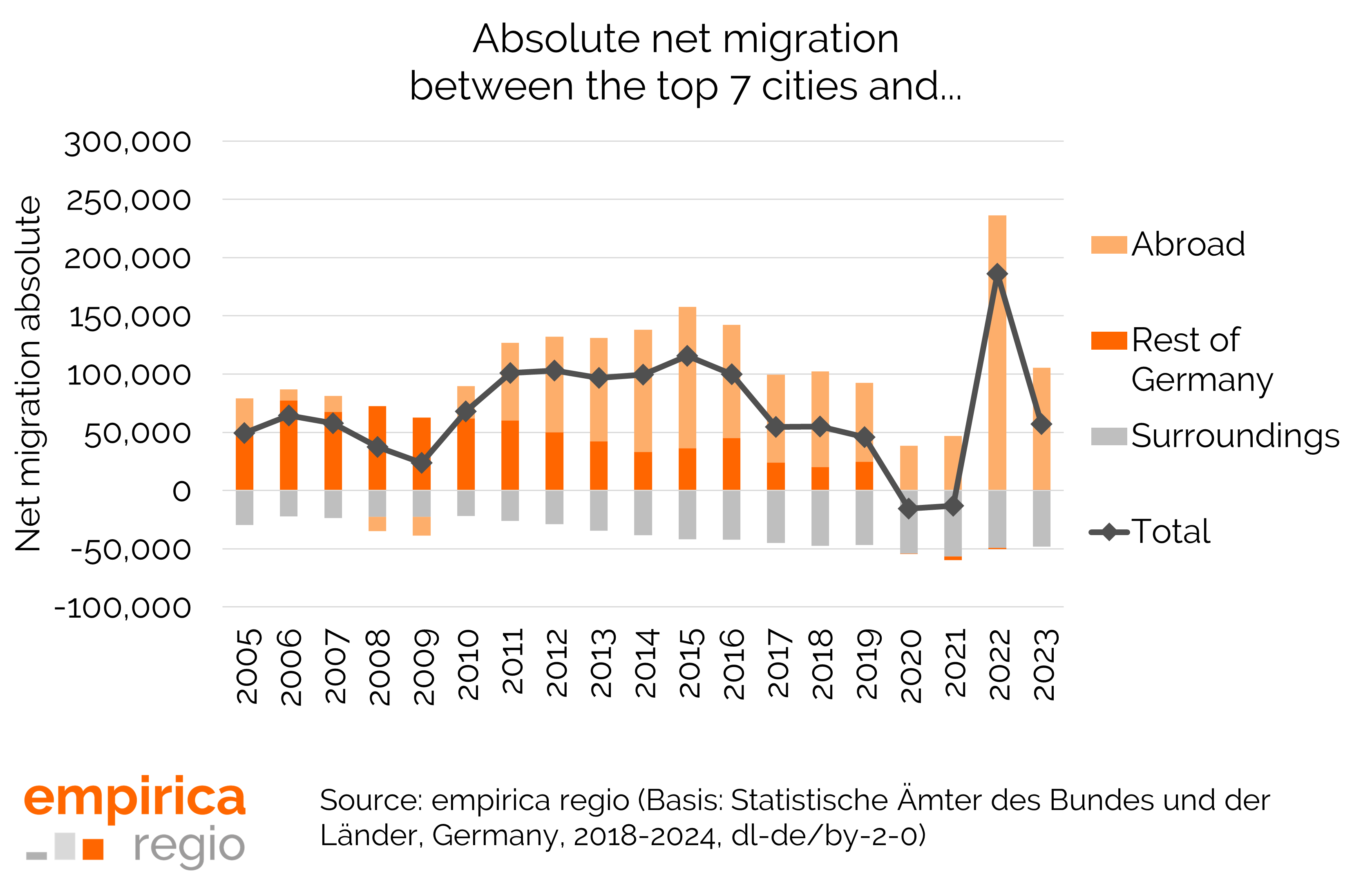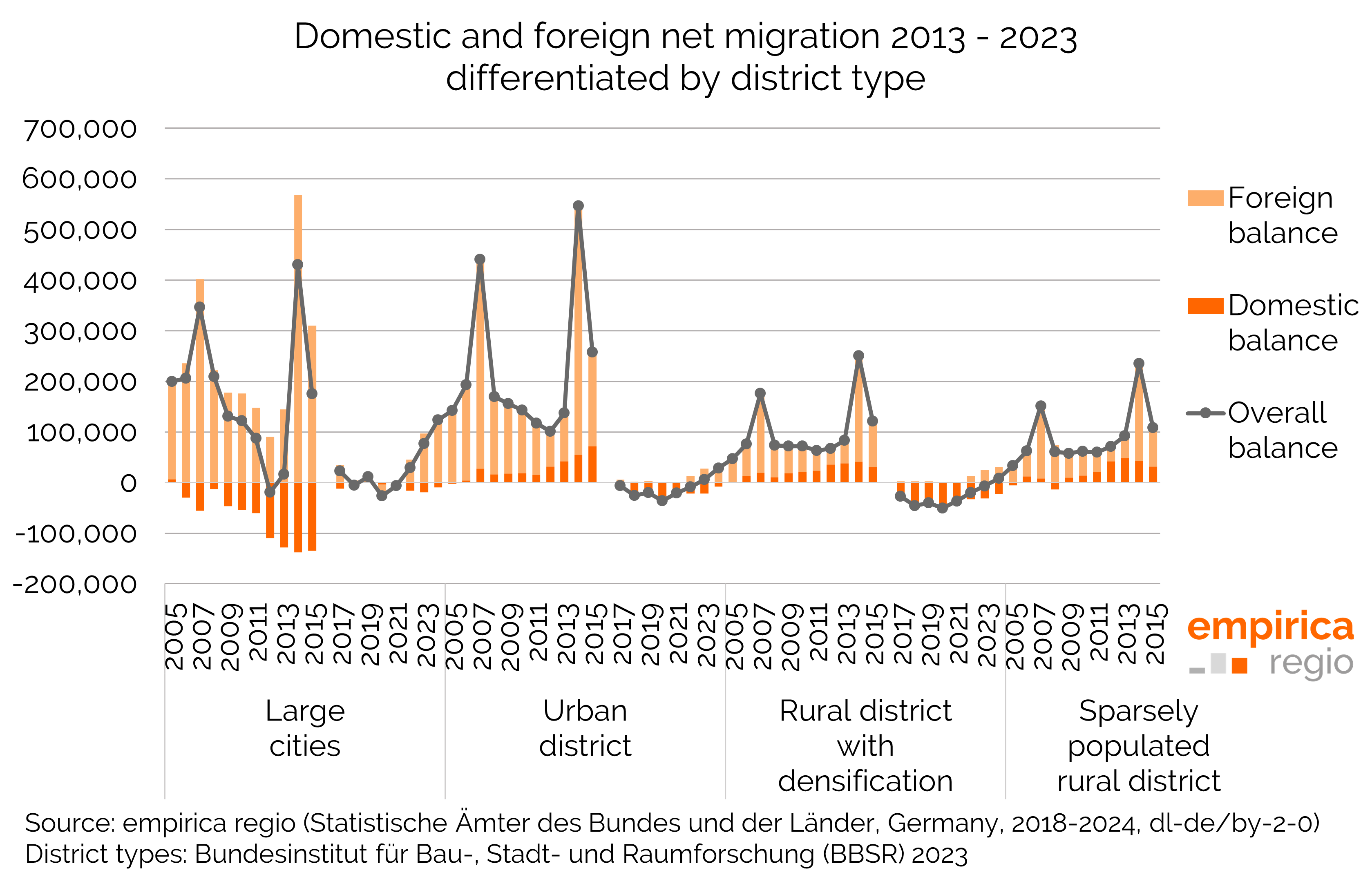Foreign immigration remains at a high level despite decline
Immigration from abroad to Germany remains at a high level in 2023, even if it is significantly lower than in the previous year. A recent analysis by economic and property data provider empirica regio GmbH shows that Germany recorded net immigration of around 660,000 people in 2023. After almost 1.5 million net immigrants in 2022 and a good 1.1 million immigrants in 2015, this is still the third-highest figure since 1992. With a good 121,000 net immigrants, Ukrainians make up the largest group of immigrants.
Munich: A major city loses - the only one among the top 7 with negative net migration
The Bavarian capital of Munich is the only one of the top 7 cities with a negative migration balance in 2023. While Munich was still able to record a positive balance of over 21,000 in-migrants in 2022, around 5,155 more people moved away than moved in in 2023. The decline in outward migration is particularly drastic: in 2022, 36,804 people moved to Munich, while in 2023 the balance was only 9,623. At the same time, negative inward migration remains high - 14,778 people moved out of Munich within Germany in 2023. These developments are leading to a slight population decline in the metropolis, according to the analysis by empirica regio.
“Large cities such as Munich benefit from the influx of young adults in terms of internal migration, although net migration has been declining for several years. Immigration of young professionals has decreased and is partially failing to drive growth. The number of young adults, i.e. potential immigrants, has fallen in rural areas due to smaller birth cohorts and the migration of the parent generation to the cities. At the same time, scarcity and high prices are making it more difficult for young people to access the housing market,” says Jan Grade, Managing Director of empirica regio, analysing the situation. At the same time, more and more people are prepared to accept longer commuting times to the cities. Even districts an hour or more away are benefiting from internal migration from the major cities. This is particularly true of Munich, as suburbanisation is increasingly affecting the second and sometimes even third ring of the surrounding districts.
Berlin and Hamburg: Strong immigration despite significant declines
Berlin recorded a net immigration of 84,584 people in 2022, which corresponded to a good 2.3 per cent of Berlin’s total population and was mainly due to the refugee movements triggered by the war in Ukraine. Immigration also remained high in 2023, albeit significantly lower than in the previous year at 32,765 people. Overall, the capital remains one of the biggest immigration magnets in Germany. However, without the continued strong outward migration of 49,550 people, Berlin would actually have a negative net migration balance due to internal outward migration of 16,785 people. The majority of this balance, around 15,500 people, go to neighbouring districts or Potsdam.
Hamburg remains attractive for immigrants in 2023 with a net migration of 19,887 people, although here too there is a drastic decline compared to the particularly high level of immigration in 2022 with 39,482 people. However, according to the analysis by empirica regio, a clearly positive external migration balance of 22,103 people contrasts with a slightly negative internal migration balance of -2,216 people. However, if one differentiates between the surrounding area and the rest of the federal territory, it becomes clear that a slight migration gain of 5,234 people was achieved from the federal territory, although the negative balance from the surrounding area slightly outweighs this at 7,450.
Cologne, Frankfurt, Düsseldorf and Stuttgart stabilise domestic migration
After a slight immigration surplus of 11,943 people in 2022, the influx to Cologne is levelling out again. In total, 4,097 more people moved to Cologne in 2023 than left the city. The influx from abroad also weakened significantly in 2023 compared to the previous year. While net outward migration was still just under 20,000 people in 2022, it was 11,850 people in 2023. In terms of internal migration, the figures remain stable compared to the previous year with a negative balance of 7,753 outflows. With a negative balance of 6,159 people, the balance with the surrounding area remains similar to that with the rest of Germany, to which 1,594 people left on balance in 2023.
While a net total of 11,837 people moved to Frankfurt in 2022, the number of people moving in and out of the city was almost equal in 2023. Only 1,032 more people moved to the Main metropolis than moved away. External migration is also responsible for the slight population growth due to immigration, which is significantly lower in 2023 with a balance of 2,927 people than in 2022 with a balance of 15,126 people. In terms of internal migration, losses to the surrounding area of 5,218 people in 2023 can only be partially offset by immigration from the rest of Germany of 3,323 people.
As in most major cities, the positive migration balance in Düsseldorf is primarily due to the strong influx of people from abroad in the last two years, although here, too, immigration will fall significantly from 10,320 people in 2022 to 3,262 people in 2023. The main driver of this development is the decline in immigration from abroad from 12,520 people in 2022 to 3,902 people in 2023. Domestic migration is only slightly negative with a balance of 640 out-migrations, as out-migrations to the surrounding area can be largely offset by in-migrations from the rest of Germany.
Although Stuttgart recorded a slight net influx of 1,302 people in 2023, this is a drastic decline of a good 81 per cent compared to the 6,919 net inflows in 2022. The decline in outward migration is not quite as sharp. In 2023, a net 4,383 people moved to Stuttgart from abroad, compared to 12,112 people in 2022. The negative internal migration balance is slowly recovering after an interim high of 7,664 net internal migrations to only 3,081 net internal migrations in 2023. Outward migration to the surrounding area remains relatively high with a balance of 3,984 people, but migration gains of 903 people from the rest of Germany could be achieved again for the first time since 2019.
“Most of the top 7 cities show that foreign immigration is a key driver of urban growth. Domestic migration, on the other hand, is increasingly having an impact on the surrounding areas and cannot be offset by inward migration from the rest of Germany in all of the seven cities. This shift to the surrounding areas is due to a shortage of supply and high costs in the centres,” says Grade.
Where immigration is particularly strong: top regions in 2023
Alongside Berlin and Hamburg, the city of Bremen recorded particularly strong net immigration of 8,943 people in 2023, compared to 7,781 in 2022. 8,760 people moved to the Hanover region in 2023, compared to 20,929 in the previous year. Dresden recorded 4,892 new arrivals compared to 9,572 in 2022.
Munich, the district of Heidekreis and the city of Bonn with the highest migration
In 2023, however, there were also numerous regions that were affected by net outward migration. Munich, which had a negative net migration of 21,025 people in 2022, reduced this to 5,155 people in 2023. The district of Heidekreis also saw a high level of outward migration, although this was reduced from 3,454 people in 2022 to 1,299 people in 2023. In Bonn, outmigration fell from 4,879 people in 2022 to 122 people in 2023. Similar trends were seen in Jena, where outmigration fell from 2,727 people in 2022 to 57 people in 2023, and in Bremerhaven, which recorded a decline from 1,127 people in 2022 to 21 people in 2023.
Although 85 districts and independent cities had a negative population balance, this was the result of a negative natural population trend (births minus deaths), which could not be offset by migration alone. “The high level of outward migration has meant that in 2023 there are only 5 districts and independent cities that are shrinking in terms of net migration,” says Jan Grade.
Outward migration: Berlin and Giessen with the highest outward migration
Berlin again recorded the highest net immigration from abroad in 2023. This was followed by the district of Giessen with 24,797 people, although this is a decrease compared to the 30,350 people in 2022. Heidelberg and Essen are also experiencing strong foreign immigration, with Heidelberg recording a slight increase to 17,606 people, while Essen recorded a slight decrease to 13,358 people in 2023 compared to 15,561 in 2022.
“These figures show that many regions continue to be attractive for international immigrants. However, immigration in 2023 and especially 2022 was also strongly influenced by refugees from Ukraine. This had an impact on all districts and independent cities nationwide,” emphasises Jan Grade.
Strongest internal migration in the Wesel and Main-Kinzig districts
The strongest internal migration in Germany in 2023 was recorded by the district of Wesel with an increase of 3,805 people compared to 3,486 people in the previous year. The Main-Kinzig district followed with 3,376 people, while the district of Leipzig recorded a significant increase from 2,135 people in 2022 to 2,972 people in 2023 based on empirica regio data.
Internal migration: Giessen and Heidelberg particularly affected
Internal migration in particular caused problems for some regions in 2023. The district of Giessen led the way with a negative balance of 22,342 people, which nevertheless represents a slight upward trend compared to the 24,053 net outflows in the previous year. Heidelberg also saw a significant outflow of 16,895 people after 14,532 in the previous year. Berlin and Munich also recorded significant internal migration within Germany, although Munich was able to stabilise its internal migration somewhat with a negative target of 15,779 people in 2022 and 14,778 people in 2023. The trend in Mönchengladbach was particularly striking, with negative net migration rising from 3,943 people in 2022 to 11,771 people in 2023. With these peak values, however, it should be borne in mind that refugee accommodation can lead to distortions in individual years. It is therefore important to observe the long-term trends in internal migration.
“Internal migration remains one of the biggest challenges for many regions. Cities and districts in rural areas or city centres with scarce housing and high prices are particularly affected. The districts surrounding metropolises are currently benefiting the most from this,” says Jan Grade.





